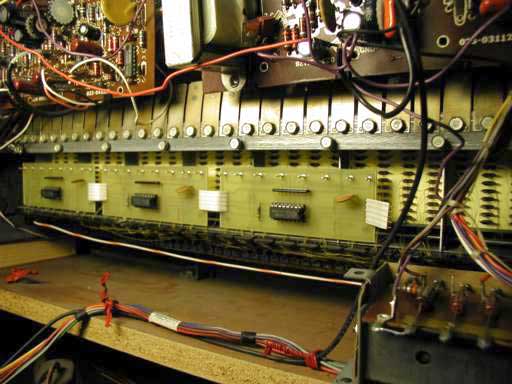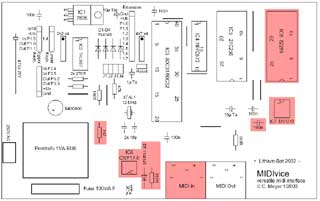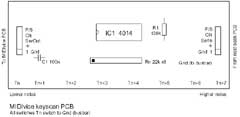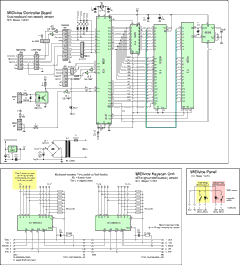|
|
|
|
MIDIvice 2 controller PCB mounted in a T-500 |
MIDIvice Keyscan Units mounted in a T-500 (upper manual shown), using brush and percussion key contacts |
This is my T-Series MIDIvice, now under beta testing. It scans both keyboards, sending MIDI on different channels and has a simple two-button user interface. It works with a dirt-cheap 8031 and single-sided PCBs -- total cost will not exceed 40 US-$ for parts. Wiring is reduced to a minimum of 5 wires to each manual. You can choose one of 44 GM program setups by simply pressing a pushbutton and one of the manual keys. You may change the default MIDI program change sequences (256 Bytes per setup) stored in EPROM to your own needs. Best of it: You will find schematics, printed circuit layout and EPROM HEX file here -- it's freeware! Interested? First download the complete MIDIvice 1.0 schematics.
MIDIvice consist of three major parts: The MIDIvice Controller Board, the Keyscan Units (you need one PCB for each 8 keys, i.e. 12 boards for a spinett organ) and a very simple "user interface" Panel.Wiring is extremely easy due to the serial 5-wire-interface to the keyscan units which fit snugly behind the key combs (see right picture above).
|
MIDIvice Controller Board (1 needed) |
MIDIvice Keyscan Unit PCB (6 needed for 44 keys, 8 needed for 61 key console manual) |
MIDIvice Controller Board and Keyscan Units Schematic |
Download the MIDIvice PCB layout PDF and etch boards as needed. Instructions how to etch a PCB from a printed layout can be found around the web, but I suppose you have already done this before. I do NOT recommend this as a beginner's PCB etching project! The transformer has to be replaced with a 117V type for those living in US. Warning: There are dangerous voltages present on the board when connected to mains power!
For the freeware version 1.01 of MIDIvice, omit IC6, IC7, IC8, MIDI in, lithium battery and extension connector (parts marked red) when furnishing the PCBs. The EPROM 27C256 IC5 has to be programmed with the MIDIvice spin44 firmware 1.01; If you want the improved shareware version or need a programmed EPROM (10$ plus shipping), simply follow the "Buy Now" link below or drop me a line.
Wiring the manuals
Percussion or brush contacts (first/upper row of contacts under the manual keys) may be connected directly to the Keyscan Units without removing the attached 220kOhm resistors. You may bring the lower manual in a working position by loosening it's screws and tilting down so it is very easy to access. I mounted the PCBs by simply glueing them to the sheet metal frame with hot glue, using a thin spacer strip to prevent short circuits. Don't forget to connect the busbar wire to a ground pin of one of the Keyscan Units. 5 wires of the last lower Keyscan Unit lead to the MIDIvice Controller Board, separately for each manual.
MIDIvice provides an output for single-trigger percussion on T-Series organs, since the percussion contacts in the upper manual are used for MIDI scanning. Just reconnect the red/white percussion busbar cable from the Hammond percussion board to the /Persussion output of the MIDIvice Controller Board with a 47kOhms resistor in series. So you don't need my percussion modification circuit.
Using MIDIvice
MIDIvice transmits on two consecutive MIDI channels (jumper-defined Base Channel on upper manual, Base Channel +1 on lower manual). Future Versions will provide Base Channel +2 for bass pedals. Four jumpers on the MIDIvice controller board set the base octave and channel configuration -- see schematics. Default (=no jumper) MIDI upper manual channel is 1 (lower manual +1 = 2), default MIDI note on lower manual is 0x1D (F1), on upper manual 0x29 (F2).
MIDIvice uses a simple two pushbutton "user interface". Pressing the "ProgChange" momentary switch blinks the adjacent LED and waits for a single key (lower manual) to be pressed. Pressing the first F key on a spinett manual sends out MIDI Program Change to program 1. If you decide not to do a program change, press the button again. The LED stops blinking an MIDIvice returns do normal key scanning operation.
Pressing the "Preset" button also waits for a (lower) manual key to be pressed, but sends out a predefined MIDI data sequence. The default MIDIvice 1 EPROM firmware comes with 44 two-byte MIDI program change sequences programmed in EPROM, starting at addresses 0x2000, 0x2100, 0x2200 and so on. If you have a hex editor, you may change these sequences to your own needs. All MIDI sequences may be up to 255 bytes long and must end with an 0xFF. SysEx and NRP data are allowed.
MIDI Bass Pedal and other keyboards
MIDIvice is not limited to Hammond organs or keyboard scanning. Example: MIDIfy an old console organ's bass pedal by adding single-contact switches for each key. You need 3 MIDIvice Keyscan Unit PCBs, simply omit the lower manual stuff. Contacts must switch to MIDIvice's ground (Gnd). Use the 61-key firmware (see below) for this purpose since the 44-key spinet version starts at an odd key number.
Improved Features
An improved version 2.0 (shareware) will also record your own 44 setup sequences from a MIDI input by pressing a "record" button, so you can easily change your MIDI setup by feeding the MIDI program, bank switch and SysEx data (256 bytes max. per setup) to the MIDIvice. It has a CMOS battery backup, so it will remember your programs when switched off. It also has support for bass pedals and a built-in MIDI merger, which mixes incoming MIDI data (from a sequencer or a masterkeyboard) to the MIDI events produced by the MIDIvice. MIDIvice 2 is supplied only as a customized, ready-programmed EPROM for 50$.
If you understand german, I recommend reading my publication of the MIDIvice 3 in german computer magazine c't. This is a very improved version of the MIDIvice, and it is also available in kit form.



